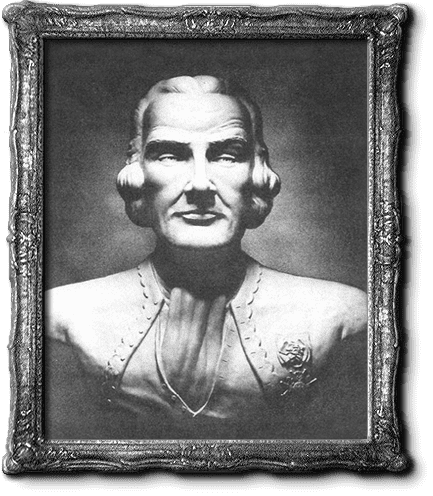Name Louis de | Role Explorer | |
 | ||
Died June 11, 1744, Natchitoches, Louisiana, United States | ||
Louis Antoine Juchereau de St. Denis (September 17, 1676 – June 11, 1744) was a French-Canadian soldier and explorer best known for his exploration and development of the Louisiana (New France) and Spanish Texas regions. He commanded a small garrison at Fort de la Boulaye on the lower Mississippi River, built in 1700, and founded Fort Natchitoches in northern La Louisiane, as they called the French colony.
Contents
Early life and education
He was born at Beauport, New France (Quebec), the eleventh of the twelve children of Nicolas Juchereau (1627-1692), Seigneur du Chesnay and Saint-Roch-des-Aulnaies; member of the Sovereign Council of New France. His paternal grandfather was the elder brother of Noel Juchereau des Chatelets. His mother, Marie Therese Giffard de Beauport, was the daughter of Robert Giffard de Moncel, Sieur de Moncel a Autheuil, and the 1st Seigneur of Beauport, Quebec. His brother was the grandfather of Louis Barbe Juchereau de Saint-Denys (1740-1833), 1st Marquis de Saint-Denys, ancestor of Marie-Jean-Leon, Marquis d'Hervey de Saint Denys
His parents apparently were able to send St. Denis to France to further his education. In late 1699, St. Denis sailed from La Rochelle with the second expedition of Pierre Le Moyne, Sieur d'Iberville (his first cousin), arriving in Louisiana. St. Denis commanded a small garrison at Fort de La Boulaye, named for a commune in the Bourgogne region of France. The fort was constructed in 1700 on the Mississippi River about 20 kilometers below the future development of New Orleans; it was designed to protect French interests against the Spanish and English in the region. St. Denis He also commanded a fort at Biloxi Bay, where the French founded another settlement. St. Denis also explored to the west of the bay and up the Mississippi River, where he journeyed to the lower Red River. These expeditions to the northern areas brought St. Denis into contact with the Karankawa and Caddo tribes and taught him invaluable wilderness skills specific to the area.
Antoine Laumet de La Mothe, Sieur de Cadillac, sent St. Denis and a company of men from Mobile in September 1713 to travel up the Red River and establish a French outpost. St. Denis arrived in Natchitoches in present-day northern Louisiana later that year and built Fort Natchitoches as a trading post. He traded with the Caddo Nation there and freely sold them guns. The French learned many hunting and trapping skills from the Caddo Indians.
Soon after founding Natchitoches (1714), St. Denis traveled to the lands of the Hasinai Confederacy, a group of Caddoan language tribes, and from there to Spanish outposts on the Rio Grande. At San Juan Bautista, Coahuila, Commander Diego Ramon placed St. Denis under house arrest. He confiscated his goods while awaiting instructions from Mexico City, on what to do with the foreigner charged with violating Spanish trade restrictions. In the meantime, St. Denis courted and won the promise of marriage from Ramon's step-granddaughter, Manuela Sanchez-Navarro a descendant of the conquistadors of the provinces of Nueva Vizcaya and Nuevo Leon, Mexico. St. Denis was ordered to Mexico City and defended himself well enough to be appointed the commissary officer of the Ramon expedition charged with founding Spanish missions in east Texas.
St. Denis returned to San Juan Bautista and married Manuela in early 1716. In the years 1716-1717 he traveled to eastern Tejas to participate in the founding of six missions and a presidio. He returned to San Juan Bautista in April 1717. The death of Louis XIV and the conclusion of the War of Spanish Succession resulted in ending French-Spanish cooperation, and St. Denis returned to La Louisiane. The French sent St. Denis to Mexico City for a second time, but he escaped before being hauled to Spain as a prisoner. St. Denis made his way to Natchitoches by February 1719. Spanish officials permitted Manuela to join him in 1721, and the couple spent their remaining years at the French outpost, Le Poste des Cadodaquious, on the Red River.
Later life
From his command at Natchitoches, St. Denis was a troublesome thorn in the side of Spanish Texas. Controversy surrounds his motives to this day. St. Denis insisted that he wanted to become a Spanish subject, and his Spanish wife was proof. Suspicious Spaniards saw him as a covert agent of France. St. Denis contributed greatly to the geographical knowledge of both imperial France and imperial Spain, as well as bringing Spanish and French settlements into closer proximity and contact. His contraband trade became a way of life on the frontier and borders of Spanish Texas and French Louisiana.
On 10 January 1743, he wrote to Jean-Frederic Phelypeaux, comte de Maurepas, at Versailles, indicating that he could no longer perform his duties as commandant of Natchitoches. He also asked permission to retire to New Spain with his wife and children, but he was forbidden to do so. St. Denis died at Natchitoches on 11 June 1744. He was survived by his wife and five children, one of whom was married briefly to Athanase de Mezieres.
As his two sons did not father any children of their own, his daughters carried his posterity. His descendants include Jefferson J. DeBlanc (1921-2007) and Alcibiades DeBlanc (1821-1883), who founded the Knights of the White Camellia, a post-Civil War white insurgent group in Louisiana. Its goal was to suppress voting by freedmen and regain political power for white men.
